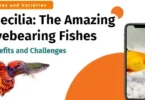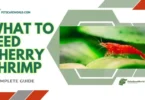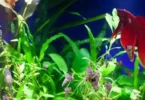Are you looking to add a vibrant and eye-catching fish to your aquarium? Look no further than the gourami! Gouramis are known for their stunning colors, unique personalities, and ease of care. In this article, we will explore the world of gouramis, including their various species, habitat requirements, care tips, and more. So, let’s dive in and discover the beauty of these mesmerizing fish.
Gouramis: Popular Gourami Species
Gouramis belong to the family Osphronemidae and are native to Southeast Asia. Freshwater fish are known for their vibrant colors, long fins, and labyrinth organs, enabling them to breathe air directly from the surface. Gouramis are available in various species, each exhibiting unique characteristics and colors.
Dwarf Gourami
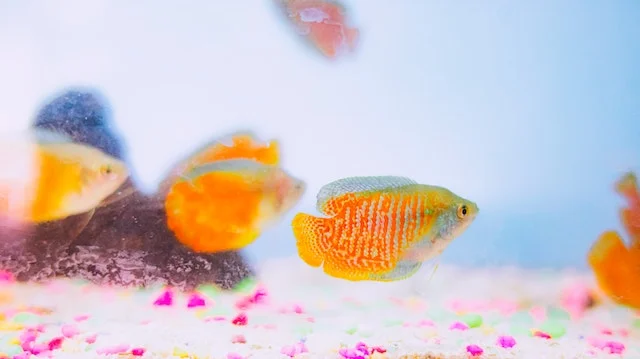
Dwarf gouramis (Trichogaster lalius) are one of the most popular gourami species in the aquarium hobby. They showcase brilliant hues of red, blue, and yellow, making them a visually appealing choice for aquarium enthusiasts. Dwarf gouramis are peaceful and can be kept in community tanks with other peaceful fish.
Pearl Gourami
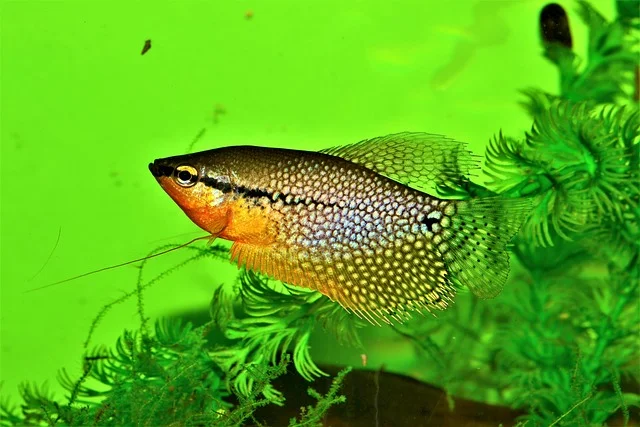
Pearl gouramis (Trichogaster leeri) are known for their iridescent scales, which resemble delicate pearls. These gouramis exhibit a peaceful temperament and can coexist with other peaceful species.Their elegant appearance and calm nature make them a favorite among aquarists.
Honey Gourami
Honey gouramis (Trichogaster chuna) are small in size and boast stunning shades of orange and gold. They are well-suited for smaller aquariums and can coexist with other peaceful fish. Honey gouramis are relatively hardy and a great choice for beginners.
Setting Up the Ideal Habitat
Tank Size and Setup
Gouramis require spacious tanks to thrive. A minimum tank size of 20 gallons is recommended for most species, although larger tanks provide a better environment. Setting up the aquarium with appropriate filtration, heating, and lighting systems is important.
| Gourami Species | Minimum Tank Size for a Pair |
|---|---|
| Dwarf Gourami | 20 gallons (76 liters) |
| Honey Gourami | 20 gallons (76 liters) |
| Pearl Gourami | 40 gallons (151 liters) |
| Blue Gourami | 40 gallons (151 liters) |
| Opaline Gourami | 40 gallons (151 liters) |
| Three-Spot Gourami | 40 gallons (151 liters) |
| Moonlight Gourami | 40 gallons (151 liters) |
| Paradise Gourami | 40 gallons (151 liters) |
| Kissing Gourami | 75 gallons (283 liters) |
| Giant Gourami | 150 gallons (567 liters) |
Water Conditions
Gouramis prefer slightly acidic to neutral water conditions with a pH range of 6.0 to 7.5. Maintain the water temperature between 75°F and 82°F (24°C to 28°C). Investing in a reliable heater and thermometer is essential to maintain stable water parameters.
Aquatic Plants and Decorations
Aquatic plants and decorations are important for creating a natural environment in the aquarium. Gouramis appreciate the presence of live plants, which provide hiding spots and simulate their natural habitat. Floating plants, such as Amazon frogbit or water lettuce, are particularly favored by gouramis.
Feeding and Nutrition
Gourami Diet
Gouramis are omnivorous fish, and their diet should consist of a variety of foods. High-quality dry flakes or pellets formulated specifically for tropical fish serve as a good staple diet. Supplement their diet with live or frozen foods such as brine shrimp, bloodworms, and daphnia to provide essential nutrients.
- Pellets: High-quality commercial fish pellets designed for tropical fish can be a staple in their diet.
- Flakes: Tropical fish flakes are readily available and can be part of their daily feeding routine.
- Live Food: Gouramis enjoy live food such as brine shrimp, daphnia, and mosquito larvae. These provide essential nutrients and mimic their natural diet.
- Frozen Food: Offer frozen foods like bloodworms and brine shrimp as occasional treats. These foods are rich in proteins and are a favorite among Gouramis.
- Vegetables: Supplement their diet with blanched vegetables like spinach, zucchini, or peas. These provide fiber and essential vitamins.
- Algae Wafers: Gouramis may nibble on algae wafers. While they are not primarily herbivores, they can benefit from the occasional plant matter.
- Insects: Small insects like fruit flies and small crickets can be offered as occasional treats. Ensure these insects are appropriately sized for your Gourami.
- Variety: Aim for a balanced diet that includes a variety of these food types. This ensures your Gouramis receive all the necessary nutrients for their health and vibrant coloration.
- Frequency: Feed your Gouramis small amounts 2-3 times a day, only as much as they can consume within a few minutes. Overfeeding can lead to water quality issues.
Feeding Schedule
Feed your gouramis in small portions two to three times a day. Avoid overfeeding as it can cause health problems and compromise water quality. Observe their eating habits and adjust the feeding schedule accordingly. Here’s a sample feeding schedule to help you ensure your Gouramis receive the proper nutrition:
Morning (9:00 AM):
- Offer a small portion of high-quality tropical fish flakes. These flakes should float on the water’s surface, making it easy for Gouramis to feed.
Midday (1:00 PM):
- Provide a serving of live or frozen food. Options include brine shrimp, daphnia, or bloodworms. Thaw frozen food before feeding to prevent digestive issues.
Afternoon (4:00 PM):
- Offer blanched vegetables such as spinach, zucchini, or peas. These should be cut into small, manageable pieces. Ensure any uneaten vegetables are removed after a couple of hours to maintain water quality.
Evening (7:00 PM):
- Include a small portion of high-quality fish pellets. These can sink to the bottom of the tank, providing variety in feeding behavior for Gouramis.
Bedtime (10:00 PM):
- It’s essential to maintain a regular schedule, but at night, Gouramis do not require feeding. Having a resting period without food helps mimic their natural environment.
Weekly Variation:
- Once a week, replace one of the daily feedings with live or frozen insects like fruit flies or crickets. This adds excitement to their diet and provides essential nutrients.
Note: Always monitor your Gouramis during feeding to ensure they consume their food within a few minutes. Overfeeding can lead to water quality issues and health problems. Adjust the portion size based on the number of Gouramis in your tank and their individual appetites. Additionally, provide a balanced diet that includes a variety of foods to meet their nutritional needs.
Supplemental Foods
In addition to commercial foods, gouramis benefit from occasional treats of fresh vegetables, such as blanched spinach or peas. These provide essential vitamins and fiber. Offering a varied diet ensures the overall health and vitality of your gouramis.
Here are some supplemental foods to consider:
- Live Foods:
- Brine Shrimp: These small crustaceans are a favorite among Gouramis. They provide essential proteins and stimulate natural hunting behaviors.
- Daphnia: Tiny water fleas, often called “water fleas,” are rich in nutrients and promote good health.
- Mosquito Larvae: If you have a source of mosquito larvae, they are a natural and nutritious treat for Gouramis.
- Frozen Foods:
- Bloodworms: These red mosquito larvae are available frozen and are high in protein. They are a favorite treat for many fish species.
- Tubifex Worms: Frozen tubifex worms are a good source of protein but should be fed sparingly due to the risk of disease transmission.
- Vegetables:
- Zucchini: Blanched zucchini slices can be offered as a supplementary source of fiber and essential vitamins.
- Peas: Remove the outer shell of peas, blanch them, and then cut them into small pieces. They provide fiber and help with digestion.
- Pellets and Flakes:
- While these are often the primary diet, it’s still important to vary the brands and types of pellets and flakes you use to ensure a well-rounded diet.
- Insects:
- Fruit Flies: These tiny insects are a fun and nutritious treat for Gouramis.
- Small Crickets: Ensure the crickets are appropriately sized for your Gouramis and dust them with a quality fish vitamin supplement before feeding.
- Algae Wafers:
- While Gouramis are not primarily herbivores, they may nibble on algae wafers, which can provide additional nutrition.
- Commercial Gourami Foods:
- Look for specialized Gourami foods available in pet stores. These are formulated to meet the dietary needs of Gouramis.
Gourami Behavior and Compatibility
Social Nature
Gouramis are generally peaceful and can be kept in community aquariums. However, it’s important to consider their compatibility with other fish species. Some gouramis may exhibit territorial behavior, especially during breeding or if their space is invaded.
Gourami Tankmates
Compatible tankmates for gouramis include peaceful community fish like tetras, rasboras, and corydoras catfish. Avoid housing them with aggressive or fin-nipping species that may stress or harm the gouramis. Always research the compatibility of potential tankmates before adding them to the aquarium.
| Category | Compatible Tankmates for Gouramis |
|---|---|
| Small Tetras | Neon Tetras, Cardinal Tetras, Rummy Nose Tetras |
| Rasboras | Harlequin Rasboras, Chili Rasboras, Lambchop Rasboras |
| Corydoras Catfish | Corydoras species |
| Otocinclus Catfish | Otocinclus Catfish |
| Danios | Zebra Danios, Pearl Danios |
| Other Peaceful Community Fish | Guppies, Platies, Endler’s Livebearers |
| Non-Aggressive Bottom Dwellers | Kuhli Loaches, Bristlenose Plecos |
| Snails | Nerite Snails, Mystery Snails |
Aggression and Territoriality
While gouramis are generally peaceful, some species can display territorial behavior, particularly during breeding. Providing ample hiding spots and visual barriers, such as plants or driftwood, helps reduce aggression and provides a sense of security for the fish.
Breeding Gouramis
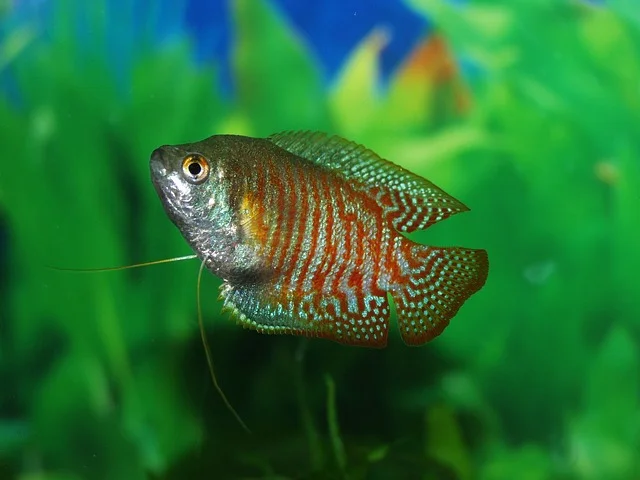
Breeding Behavior
Gouramis are known for their unique breeding behavior. Males build bubble nests at the water’s surface using saliva and plant matter. The female lays eggs after a successful courtship, and the male fertilizes them. The male gourami guards the nest and cares for the eggs and fry.
Gouramis Breeding Setup
To encourage breeding, maintain optimal water conditions, and provide suitable plants or spawning mops for the female to deposit her eggs. The male will diligently tend to the eggs and fry, ensuring their safety and well-being. Separating the breeding pair from other tankmates during the breeding process can also prevent disturbances.
Here’s a step-by-step guide on how to set up a Gourami breeding tank:
1. Select the Right Gourami Species:
- Ensure you have a male and female pair of Gouramis. Some species, like Dwarf Gouramis, are easier to breed in captivity.
2. Separate Breeding Tank:
- Set up a separate breeding tank. A 10 to 20-gallon tank is usually sufficient for most Gourami species.
3. Water Parameters:
- Maintain stable water conditions:
- Temperature: 78-82°F (25-28°C).
- pH: Slightly acidic to neutral (6.5-7.0).
- Ammonia and nitrite levels should be at zero, and nitrates should be low.
4. Decor and Substrate:
- Use fine-leaved plants such as Java moss or artificial spawning mops to provide hiding places for the fry.
- Include floating plants to diffuse light and provide cover for the bubble nest.
5. Filtration:
- Use a sponge filter or a gentle air-driven filter to avoid strong currents that could disrupt the bubble nest.
6. Conditioning the Breeders:
- Feed the breeding pair high-quality foods, including live or frozen foods, to condition them for breeding.
7. Introduce the Pair:
- Place the male and female Gouramis in the breeding tank together.
8. Bubble Nest:
- Male Gouramis are bubble nest builders. They will create a nest on the water’s surface using bubbles. Provide floating plants to assist in nest-building.
9. Spawning Behavior:
- Observe the courtship and spawning behavior. The male will entice the female under the bubble nest.
10. Egg Laying: – The female will release eggs, and the male will fertilize them. The male will collect the eggs and place them in the bubble nest.
11. Remove the Female: – After spawning, it’s essential to remove the female from the breeding tank to prevent her from eating the eggs or attacking the male.
12. Care for the Fry: – The male will protect the nest and the hatching fry. Once the fry is free-swimming, usually within a few days, you can start feeding them with specialized fry food or powdered flakes.
13. Maintain Water Quality: – Ensure excellent water quality in the breeding tank. Perform regular water changes to keep the environment clean.
14. Monitor Growth: – As the fry grows, you may need to separate them into a larger tank or provide additional hiding spots.
15. Offer Varied Diet: – As the fry grows, introduce a variety of small foods, including baby brine shrimp, micro worms, or finely crushed flakes.
16. Patience: – Breeding Gouramis can take time and patience. Not every attempt may be successful, so be prepared for multiple breeding attempts.
17. Record Keeping: – Keep records of breeding dates, water parameters, and any observations. This information can be valuable for future breeding attempts.
Rearing Fry
Once the eggs hatch, the male gourami continues to care for the fry. After a few days, the fry will become free-swimming and can be fed infusoria or commercially available liquid fry food. As they grow, gradually introduce finely crushed flakes or powdered fry food to their diet.
Common Diseases and Health Issues
Ich (White Spot Disease)
Ich is a common parasitic disease that affects many freshwater fish, including gouramis. It presents as white spots on the fish’s body and fins. Treating ich involves raising the water temperature and using appropriate medications as directed. Maintaining good water quality and minimizing stress can help prevent ich outbreaks.
Fin Rot
Fin rot is a bacterial infection that causes the deterioration of the fish’s fins and tail. It is often a result of poor water conditions or physical injuries. Treating fin rot involves improving water quality, performing partial water changes, and administering antibiotics if necessary. Prompt action is vital to prevent the infection from spreading.
Swim Bladder Disorder
Swim bladder disorder can affect gouramis, causing buoyancy issues and difficulty swimming properly. It can be caused by overfeeding, constipation, or bacterial infection. Providing a varied diet, avoiding overfeeding, and maintaining good water quality can help prevent swim bladder disorders. If necessary, consult a veterinarian for appropriate treatment.
Tips for Gourami Care
Regular Water Maintenance
Regular water maintenance is essential for the health and well-being of gouramis. Perform weekly partial water changes to remove toxins and maintain stable water parameters. Test the water regularly for ammonia, nitrite, nitrate, pH, and temperature to ensure optimal conditions for your fish.
Monitoring Water Parameters
Gouramis are sensitive to water quality, so it’s important to monitor the parameters regularly. Maintain ammonia and nitrite levels at zero, and keep nitrate levels below 20 ppm. Use reliable test kits to monitor these parameters and take appropriate action if any issues arise.
Providing Hiding Places
Gouramis appreciate hiding spots in the aquarium, especially during times of stress or when they seek solitude. Use live plants, driftwood, and artificial caves to create hiding places and territorial boundaries. These additions not only enhance the aesthetics of the tank but also provide security for the fish.
Conclusion
Gouramis are captivating fish that can bring life and color to your aquarium. Their vibrant colors, unique personalities, and ease of care make them a popular choice among aquarists. By providing the ideal habitat, a varied diet, and proper care, you can enjoy the beauty and charm of these stunning fish for years to come.
FAQs (Frequently Asked Questions)
Can gouramis live with other fish?
Yes, gouramis can live with other peaceful fish species. However, it’s important to research their compatibility before introducing them to the same tank. Carefully consider tankmates due to the possibility of territorial behavior in some gouramis.
How long do gouramis live?
The lifespan of gouramis can vary depending on the species and care provided. On average, gouramis can live for 3 to 5 years, but with proper care, some species can live up to 8 years or more.
Are gouramis suitable for beginners?
Sure thing! Gouramis can be great for beginners, especially types like dwarf gouramis and honey gouramis. They’re tough little fish and don’t need a lot of fuss, so they’re perfect for folks new to fishkeeping.
What size tank do gouramis require?
Gouramis require a minimum tank size of 20 gallons, although larger tanks are recommended for better swimming space. Providing ample room and suitable hiding places is essential for their well-being.
How do you prevent diseases in gouramis?
Keep your gouramis healthy by keeping their water clean, changing it regularly, and feeding them well. Don’t overfeed and make sure the tank’s environment is stable. Before adding new fish, keep them separate for a while to make sure they’re not sick and won’t make others sick.



